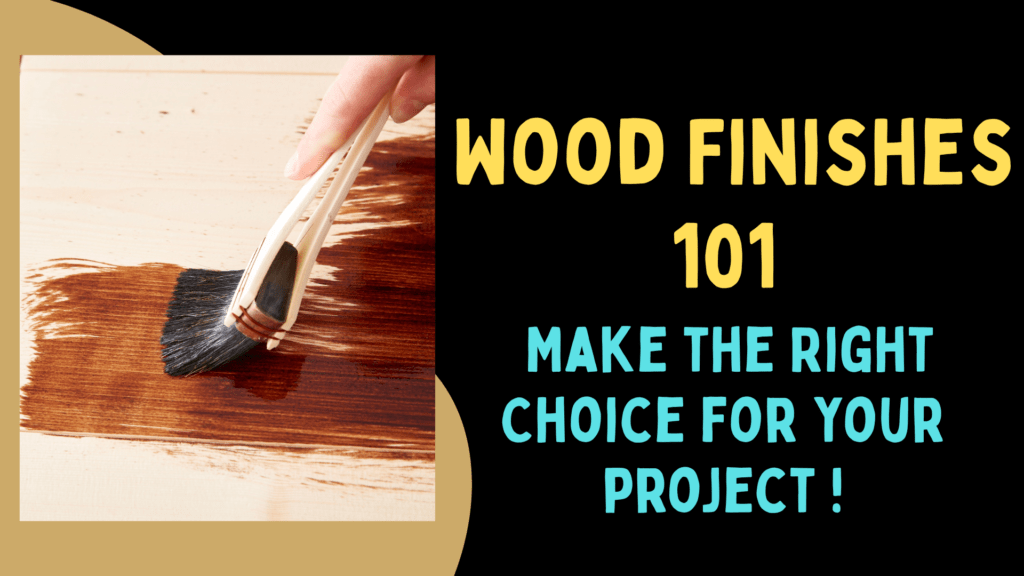
Picking the right wood finish is an important step in any woodworking, furniture repair, or DIY project. A good finish not only makes the wood look beautiful, but also protects it from things like water, sunlight, scratches, and daily use.
There are many types of wood finishes—some made from natural oils and others from modern synthetic materials. With so many options, it can be hard to know which one to choose.
This easy-to-follow guide will explain the most popular types of wood finishes, how they compare, their benefits, and tips for applying them. It will help you choose the best finish for your wood project, whether it’s a small table, a wooden floor, or a piece of furniture.
Understanding Wood Finishes: Why They Matter
Wood is a porous, organic material that can easily absorb liquids, swell, or degrade without protection. Wood finishes fulfill several critical functions:
Protection: They create a barrier against moisture, stains, scratches, and UV rays.
Aesthetic Enhancement: They highlight the wood grain, deepen color, or add a precise sheen (matte, satin, gloss).
Longevity: Proper finishing extends the life of wood by minimizing damage.
Knowing about the different types of finishes and what they do helps you choose the best one for your wood, your project, and how you want it to look.
Shellac Finish
Shellac finish is one of the oldest wood finishes, with centuries of use in furniture making and restoration. Extracted from the resin secreted by the lac bug and dissolved in alcohol, shellac dries quickly and imparts a warm amber tone that enriches the wood’s appearance.
Why Choose Shellac?
- Dries fast, allowing multiple coats in a day.
- Excellent clarity, imparting a beautiful natural glow.
- Easily repairable—damaged areas recoat seamlessly.
- Non-toxic and food-safe when cured, commonly used on kitchen cabinetry and antiques.
Limitations
- Not highly water or heat resistant.
- Prone to damage from alcohol and solvents.
- Better suited for indoor decorative wood rather than heavy-use or wet areas.
Pro Tip for Shellac Finish:
To get a perfect finish, apply thin and even layers using a good brush or pad. After each layer, gently sand the surface with fine sandpaper (320 grit or higher) to remove tiny dust particles and help the finish stick better.
If you plan to add a varnish or polyurethane layer on top, use shellac that has had the wax removed (dewaxed shellac).
Stain vs. Varnish
Many people get confused between stain and varnish, but they do different jobs.
Stain: This is a colored liquid that soaks into the wood to bring out its natural grain and add color. It changes the wood’s color but does not protect the surface. The wood’s texture stays the same.
Varnish: This is a clear or slightly tinted hard coating that sits on top of the wood (whether it’s stained or not) to protect it from water, wear, and sun damage. It makes the surface stronger and more durable.
When to Use Stain?
Use stains when you want to change or deepen wood color while keeping the natural texture and grain visible. Stains come in oil-based, water-based, gel, and dye forms, each with varying penetration and drying times.
When to Use Varnish?
Choose varnish if your goal is to protect wood surfaces largely exposed to moisture, spills, or abrasion—such as tabletops, floors, or outdoor furniture. Varnishes can be glossy or matte, producing everything from a wet-look shine to a subtle satin finish.
Stain and Varnish Combo:
Many projects benefit from first staining to enhance color, then applying varnish for protection—combining the best of both worlds.
Stain vs Varnish – Detailed Article
Varathane vs. Minwax
When it comes to wood finishing products, Varathane and Minwax are two popular and trusted brands offering a variety of stains, sealers, and polyurethanes.
Varathane:
- Known for fast drying times, excellent penetration, and durability.
- Popular for DIY projects and professional use alike.
- Offers water-based and oil-based products with low odor options.
- Usually more affordable than Minwax in many regions.
Minwax:
- Long-standing reputation for quality, especially wood stains.
- Offers a wide range of colors and specialty products like wood conditioners.
- Generally more forgiving for novices, easier to apply uniformly.
- Iconic product lines include Minwax Fast-Drying Polyurethane and Classic Wood Finish stains.
Which One to Pick?
- It boils down to your project requirements:
- If you want quick drying and strong, deep coloration, Varathane is excellent.
- For extensive color options and beginner-friendly products, Minwax is a solid choice.
- Trying both on a test wood piece before your big project helps determine personal preference.
Osmo Polyx Oil
Osmo Polyx Oil is a special wood finish made mostly from natural oils (like sunflower, soybean, and thistle oil) and natural waxes (like carnauba and candelilla wax). It helps protect wooden surfaces and also makes them look beautiful and natural.
Main Features and Benefits:
Strong Protection:
It makes wood surfaces resistant to water, dirt, stains, and scratches. Spills like wine, coffee, or beer won’t easily damage it. Once dry, it’s safe for children’s furniture and toys.
Keeps Wood Looking Natural:
Instead of sitting on top of the wood like paint, it soaks into the surface. This lets the wood “breathe,” which helps prevent cracking or swelling. It also brings out the natural grain and color of the wood, giving a warm and natural look.
Easy to Use and Maintain:
You can apply it with a brush or roller. You don’t need to use a primer or sand between coats. Usually, two thin coats are enough, with 8–10 hours drying time between them. If the surface gets damaged, you can fix just that spot—no need to sand the whole thing.
Different Looks Available:
It comes in several finishes like matte or satin, so you can choose the look you like.
Safe and Eco-Friendly:
It’s made from plant-based ingredients and is safe for people, pets, and the environment once it’s dry.
Where to Use It:
Great for indoor wooden floors (like solid wood or cork), furniture, doors, kitchen counters, and other wooden surfaces.
In Short:
Osmo Polyx Oil is a natural, strong, and easy-to-use wood finish. It protects wood while keeping its natural beauty. It’s a great choice if you want something that looks good, lasts long, and is easy to care for.
Beeswax Wood Finish
Beeswax wood finishes are centuries-old, prized for a subtle, warm sheen and natural feel. Derived from bee-produced wax, this finish nourishes and conditions wood, making grains pop while providing a smooth, silky surface.
Benefits of Beeswax Finish:
- Easy to apply and reapply.
- Food safe, ideal for cutting boards and utensils.
- Adds a soft glow without a glossy film.
- Velvety touch suitable for decorative furniture.
Limitations:
- Not water resistant.
- Susceptible to scratches and wear without additional sealing.
- Best used on interior furniture or decorative articles.
Applying beeswax is simple: rub warmed wax onto clean wood, allow to sit briefly, then buff thoroughly with a soft cloth until shiny. Frequent maintenance is needed to retain protection, especially in high-use areas.
Wood Wax Finish
Wood wax finishes, whether based on beeswax, carnauba, or synthetic waxes, create an easy-to-maintain protective layer enhancing wood’s tactile quality.
How Wood Wax Works:
Wax fills microscopic pores and creates a smooth surface that slightly repels water and dirt without altering the wood’s inherent appearance dramatically. Wax finishes do not dry or cure but rest on the surface, allowing for easy repair.
Applying Wood Wax:
- Clean and prepare wood surface.
- Apply wax paste or liquid with a cloth or brush.
- Let the wax dry slightly.
- Buff with a clean cloth or rotary buffer to desired sheen.
- Waxes are perfect for antique restoration, furniture with delicate finishes, and projects where ease of renewal is prioritized over maximum durability.
Tung Oil vs. Danish Oil
Both tung oil and Danish oil are natural penetrating oils often favored for their warm, matte finish and ease of enhancement.
Tung Oil:
- Pure tung oil penetrates deeply and hardens with exposure to oxygen.
- Provides excellent water resistance and durability.
- Leaves a smooth, natural, warm finish, suitable for hardwood flooring and wooden utensils.
- Requires several coats and curing time.
Danish Oil:
- A blend of oil (often tung or linseed) and varnish or resin.
- Dries faster than pure tung oil.
- Easier application and fewer coats needed.
- Offers more visible sheen and surface protection.
Choosing Between Them:
Select pure tung oil if you want authentic, durable protection and can invest time in multiple applications.
Choose Danish oil for quicker results and a slightly glossier protective layer.
Linseed Oil
Linseed oil is a natural oil made from the seeds of the flax plant. It’s a popular wood finish because it soaks deep into the wood, protects it, and makes it look warm and beautiful.
Here’s a simple breakdown of linseed oil as a wood finish:
Natural and Safe:
Linseed oil is made from plants, so it’s eco-friendly and safe to use both indoors and outdoors.
Makes Wood Look Better:
It gives wood a warm color—golden to amber—and highlights the natural grain, making the wood’s pattern stand out more.
Protects the Wood:
It helps seal the wood, making it resistant to water, dirt, insects, and mold. However, it’s not completely waterproof, so it’s not the best for very wet areas unless you use another finish on top.
Moves with the Wood:
Linseed oil creates a soft, flexible finish that can stretch and shrink as the wood changes with temperature or humidity. This helps prevent cracks.
Easy to Apply:
You can apply it with a brush, cloth, or roller. Just make sure to wipe off any extra oil so it doesn’t stay sticky. It dries slowly, especially raw linseed oil. Boiled linseed oil dries faster and is better for most wood projects.
Needs Upkeep:
The finish doesn’t last forever. You’ll need to reapply it every few years depending on how much the wood is used or exposed to the weather.
Two Types:
- Raw linseed oil is pure and takes a long time to dry.
- Boiled linseed oil is treated so it dries quicker, which makes it more useful for woodworking.
Some Downsides:
Linseed oil can turn slightly yellow over time. It can also show water spots and get scratched. Also, oily rags must be disposed of carefully—they can catch fire on their own if not handled properly.
In Short:
Linseed oil is a natural, easy-to-use wood finish that brings out the wood’s beauty and helps protect it. If you want a soft, warm look with simple maintenance, linseed oil—especially the boiled kind—is a great choice.
Boiled Linseed Oil
Boiled linseed oil is a traditional and widely used wood finish. It’s made by heating raw linseed oil and adding drying agents to help it dry faster. People often use it to protect and improve the look of wood, especially for furniture and indoor projects.
Key Features and Benefits:
- Dries Faster:
Raw linseed oil takes a long time to dry, but boiled linseed oil dries much quicker—usually in 1 to 2 days. This makes it better for most wood projects. - Soaks into the Wood:
It goes deep into the wood grain, making the wood stronger and more protected from water, dirt, and stains. - Makes Wood Look Beautiful:
It brings out the natural grain and color of the wood, giving it a warm, rich, slightly shiny finish. - Keeps Wood Healthy:
Boiled linseed oil stays a bit flexible after drying. This helps the wood expand and shrink without cracking. It also prevents the wood from drying out. - Easy to Apply:
You can use a cloth, brush, or rag to apply it. Wipe off any extra oil after 10–15 minutes to avoid a sticky finish. Using 2 or more thin coats gives better results. - Common Uses:
Great for furniture, wooden tools, cabinets, doors, and musical instruments. Some people also use it outdoors, but it doesn’t protect as well as modern outdoor finishes. - Needs Reapplying:
To keep wood protected and looking good, you’ll need to reapply the oil every so often. - Be Careful with Oily Rags:
Rags soaked with linseed oil can catch fire on their own if not stored properly. Always lay them flat to dry or keep them in a sealed metal container.
In Short:
Boiled linseed oil is a natural, easy-to-use finish that makes wood look warm and beautiful. It offers good protection, dries faster than raw linseed oil, and is perfect for many indoor wood projects. Just remember to apply it carefully and handle oily rags safely.
Spar Urethane vs. Polyurethane
When seeking protection, particularly for projects exposed to varying environmental conditions, the choice between spar urethane vs polyurethane is important.
Spar Urethane:
- Flexible, elastic finish suited for outdoor wood.
- Resists UV damage and moisture effectively.
- Ideal for boat wood, doors, and outdoor furniture.
- Typically satin or semi-gloss sheen.
Polyurethane:
- Hard, durable finish excellent for indoor wood.
- Resistant to abrasion, heat, and chemicals.
- Available in oil-based and water-based formulas.
- Gloss spectrum from matte to high gloss.
Pro Tip:
Use spar urethane for outdoor projects exposed to the elements and polyurethane for heavy-use indoor furnishings like floors or tables.
Wood Finish Wars: Lacquer or Polyurethane?
Among wood finish enthusiasts, the Lacquer vs. Polyurethane debate is longstanding and highly relevant.
Lacquer:
- Fast drying with a flawless, high-gloss finish.
- Can be sprayed for ultra-smooth surfaces.
- Penetrates wood but forms a delicate, repairable finish.
- Requires good ventilation and safety measures.
Polyurethane:
- Slower drying but much tougher and longer-lasting.
- Better resistance to chemicals and impact.
- Applied with brush or spray, cure times vary.
- Ideal for kitchen and floor applications.
- For fine furniture or musical instruments, lacquer produces a luxurious look. For durability and protection, polyurethane wins for commercial or high-traffic use.
Lacquer Finish on Wood
To achieve a professional lacquer finish, attention to detail is key:
- Use thin coats, applied with a spray gun or high-quality brush.
- Sand lightly between coats to maintain a smooth surface.
- Ensure humidity and temperature are conducive to drying.
- Always wear respiratory protection in a well-ventilated area.
- Use dewaxed shellac as a sealer under lacquer for best adhesion.
- These insider tips help woodworkers unlock the true beauty lacquer can impart.
Marine Varnish: Your Wood’s Ultimate Defender
For wood exposed to harsh environments—like marine settings—Marine varnish is the top choice. It combines multiple resins and UV absorbers to protect against sun, saltwater, and moisture decay.
Highlights include:
- Superior elasticity to withstand wood movement.
- Multiple coats create a thick, protective barrier.
- Resists cracking, peeling, and fading.
- Often comes with antifungal properties.
- Marine varnish is indispensable for boat decks, dock timber, or outdoor teak furniture.
Final Thoughts: Choosing the Right Wood Finish for Your Project
Finishing wood is both a careful skill and a creative process. To choose the best finish, you need to know about the type of wood, where you will use it, and how you want it to look. Some finishes, like shellac, give a warm, classic color, while others, like polyurethane, protect the wood very well. Oils and waxes keep the wood feeling natural and soft.
There is no single best finish for everything. Your choice depends on:
Type of wood: Different woods take finishes in different ways, so some finishes work better on certain woods.
How you will use it: Will the wood be inside or outside? Will it get a lot of use or only gentle care?
Look you want: Do you want shiny, matte, or something in between? Do you want to keep the natural color or change it?
How much care you can give: Some finishes need regular maintenance, others last longer without much work.
By thinking about these points, you can pick the right wood finish that looks great and protects your wood for a long time.

